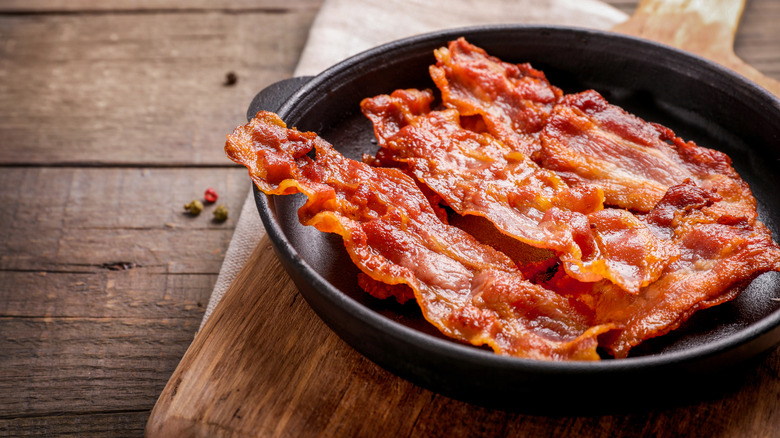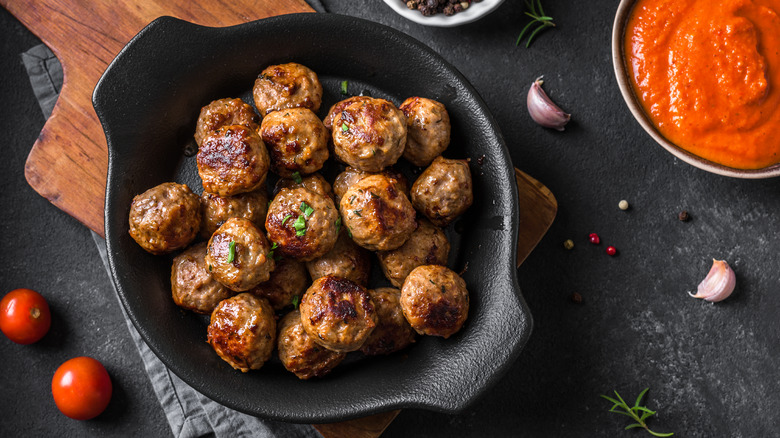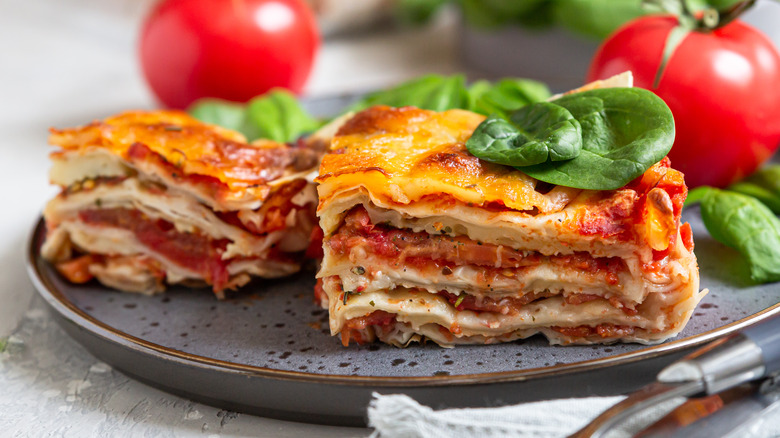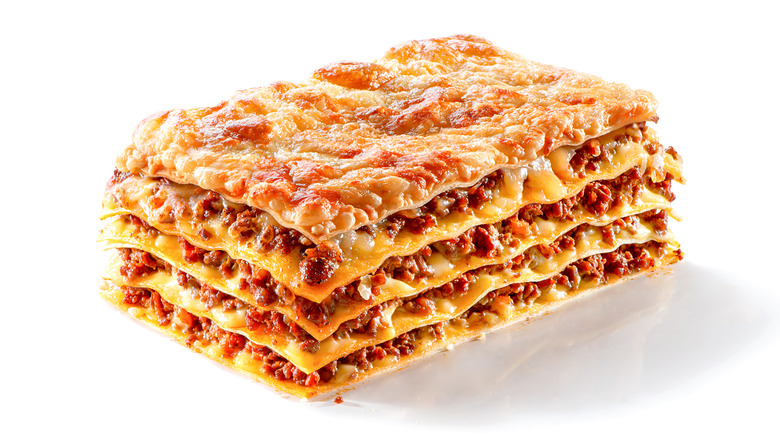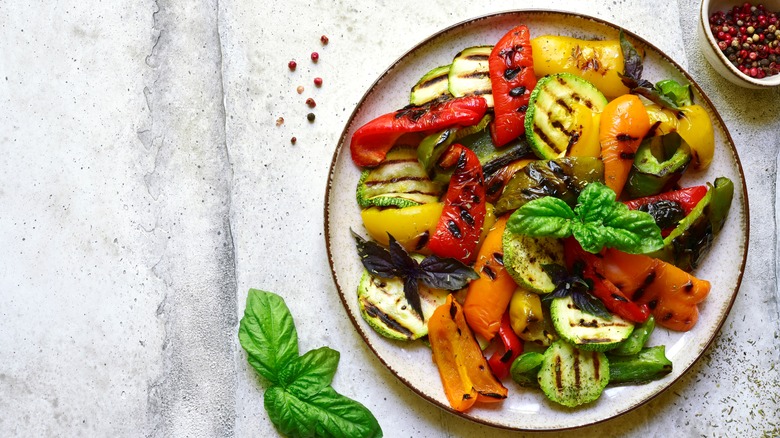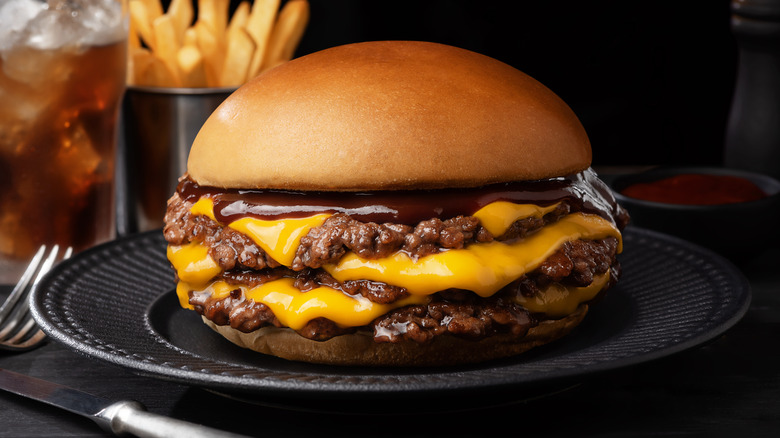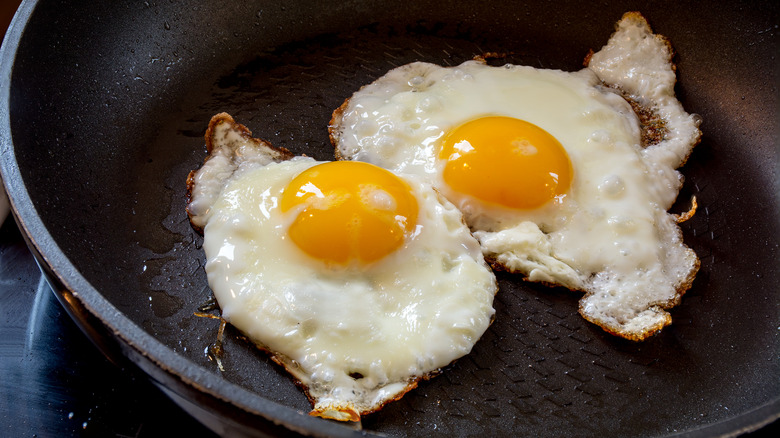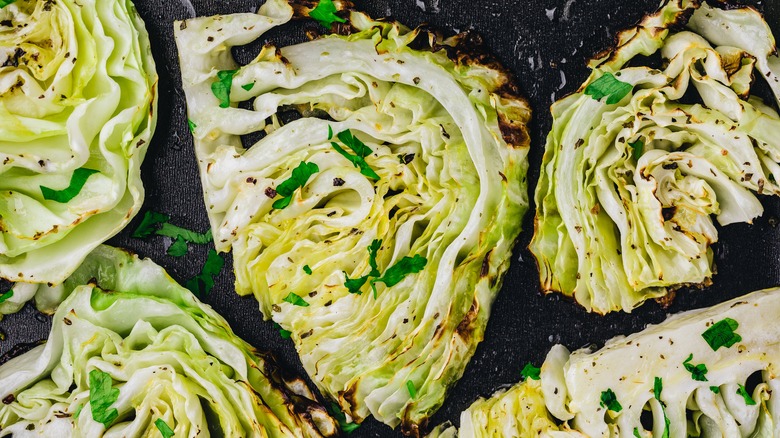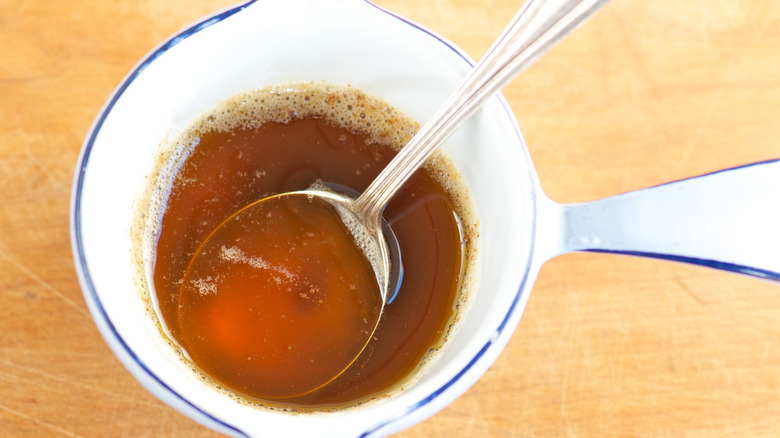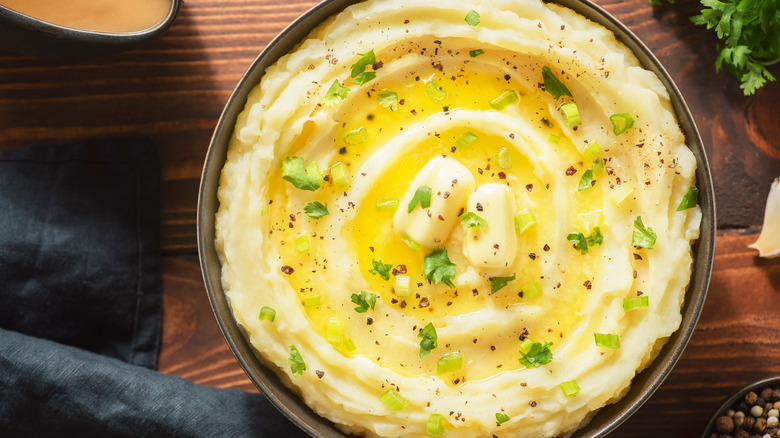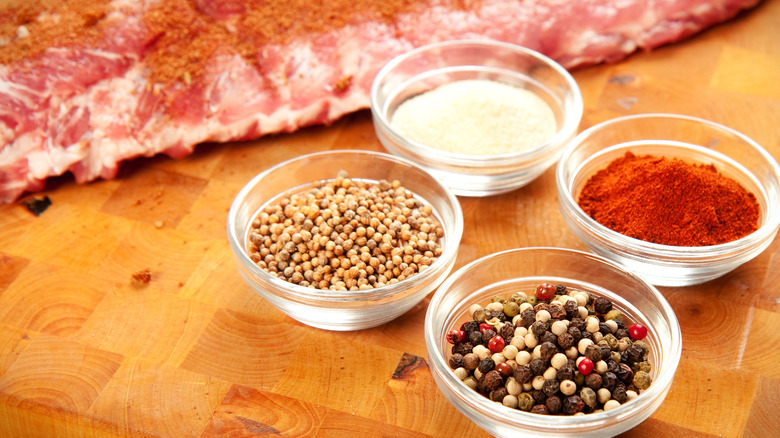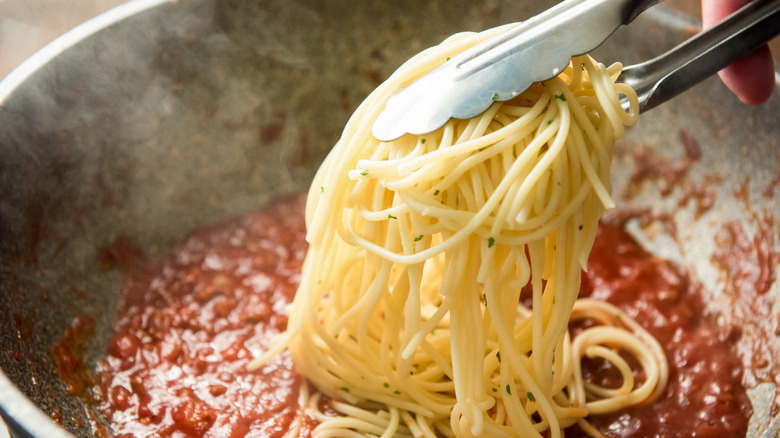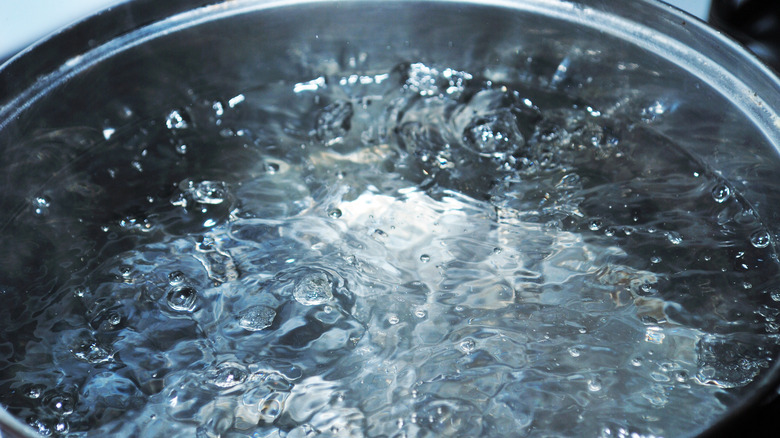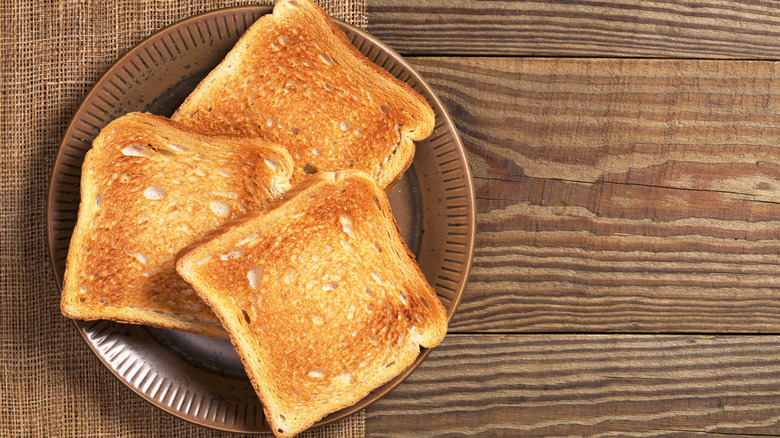Michael Symon's 14 Best Cooking Tips For Home Chefs
Who wouldn't want to level up their home cheffin' chops with Michael Symon, one of the world's foremost celebrity chefs? Bringing a down-to-earth "regular guy" approach to cooking, he knows just how to wrap professional-level techniques in accessible packaging. In fact, one untold truth about Symon you wouldn't expect is that he prefers to keep things as simple as possible. From Mediterranean-style cuisine to backyard barbecue, Symon has a penchant for home chef-friendly recipes with bold flavors.
Bold also describes his personality, which is no-frills and passionate. It's no wonder he boasts nearly 700,000 followers on Twitter, where he responds directly to fans, sharing useful tips of the trade. While it's impossible to answer every question that pops up on his timeline, Symon just might be the closest thing to a master chef-level friend you can reach out to whenever you need help over a culinary hurdle.
Whether you're a well-seasoned home chef or just learning how to sharpen your knives, his advice will fire up your hunger for cooking. Pulling from almost three decades of experience, we've compiled some of Symon's best cooking tips.
Purchase high quality pork for homemade bacon
One could easily argue that bacon is the tastiest meat in the world, after all, it comes from pork, the world's most consumed meat according to the United States Department of Agriculture. Packed with delicious umami, bacon is not only incredible by itself, but enhances the flavor of anything it's added to. That's why the only thing better than bacon is homemade bacon. With something so crave-worthy, we understand ... you're thinking that curing your own bacon requires more patience than any tummy to handle. But trust us, the flavor explosion is definitely worth the wait.
When it comes to making restaurant-quality bacon at home, meat master Symon has the cure. Now before you get to sizzling, an important tip Symon recommends is to buy quality pork. It all starts with the right pork bellies, preferably thick ones with pearly white fat. He also suggests sourcing your pork bellies from butchers that can verify the diet your pig consumed. Rather than grain-fed, a foraged food diet is best. Lastly, if you happen to live in an area where pigs are sourced locally, Symon says it's great to know the type of environment pigs are raised in. Trust — it makes all the difference when you're chomping on a crispy strip.
Add ricotta to make your meatballs juicier
Don't you love it when a food's name describes exactly what it is? While meat types and seasoning can vary, with meatballs, you pretty much know exactly what you're getting: juicy goodness. As a lover and master of all things meat-related, it should come as no surprise that Symon can whip up some mean meatballs. In fact, he has a pretty ballsy approach to ensuring the texture is tender and moist. Rather than breadcrumbs that most people use, Symon's secret ingredient for meatballs is ricotta cheese.
It's a tip that was passed down from his Greek-Sicilian mother and apparently adds fat content to meatballs, making them juicier. The trick is using the right amount of ricotta, as too much could make your balls overly soggy. Symon suggests a ratio of 1½ pounds of ground meat to 1 cup of whole milk ricotta cheese. Although he enjoys making meatballs with beef, pork, and veal, this ratio will work well with any preference of meat.
Cover lasagna with aluminum foil while baking
Growing up in a Greek-Sicilian home awarded Symon the enviable childhood of enjoying both cultures' cuisines. One food he recalls his mother making each week is lasagna, every Wednesday he could literally smell it baking from several houses away. His mother's recipe made such an impression that Symon now offers it as a menu option to hungry patrons at Angeline, an Italian restaurant he owns in Atlantic City.
Having such a strong connection to the cheesy-layered delight, when it comes to baking lasagna, Symon has a tip or two. Before you pop it into the oven to cook, he recommends covering the baking dish with aluminum foil. Covering it will help retain the cheesy meltiness as the layers bake, without overcooking and burning the top layer. Symon's recipe calls for a two-hour cook time, with an additional 10 minutes where he suggests removing the aluminum. Doing so will give the top layer a nice toasty finish.
Give your lasagna better texture with traditional noodles
According to Symon, you can take your lasagna to even tastier heights by avoiding shortcuts and using the best ingredients. That's why when cooking it, he says that no-boil noodles never belong in lasagna; you should always use traditional noodles. Although they're more popular and faster to make, Symon believes that using oven-ready noodles sacrifices flavor. Along with less flavor, no-boil noodles have inferior texture and are pre-boiled and dehydrated only to be rehydrated once cooked. Who wouldn't want their lasagna as delicious as possible?
Traditional noodles carry more starch and firmness, which will give your lasagna more structure, impacting the mouthfeel. Outside of the convenience of no-boil noodles, nearly every chef will agree that traditional, fresh pasta noodles result in a far superior lasagna. At the end of the day, it all boils down to how much time you have for cooking. By no means will using no-boil noodles prevent you from enjoying a satisfying lasagna. Underneath the layers of it all, the dish is amazing either way.
Avoid overcooking veggies by keeping a cool grill
Perfectly grilling veggies can be a tricky feat. Exposure to an open flame can easily lead to overcooking. Thankfully, the grill lords have blessed Symon with the ultimate barbecue tips to show us the light. Typically when you think of grilling, veggies are the last thing on the list. According to Symon, root vegetables are an underrated addition to your barbecue menu. It all comes down to making sure the grilling conditions are right.
Your flame should be hot, but only on one side of the grill. The other side should remain cool, and serve as a place for veggies to finish cooking. Use this tip, especially for thicker veggies, which can be cooked inside a lidded pan after being removed from the flame. An enclosed pan will trap the heat within, allowing the veggies to cook through without overcooking. Besides veggies, this method works for all sorts of foods that you can grill using a pan. If you plan to cook them directly on the grill, Symon suggests using a grilling basket. It allows for more consistency and makes it easier to flip several veggies at once rather than one by one.
Keep oiled butcher paper handy for perfect smash burgers
Another food this Cleveland cleave-master is known for making is perfect smash burgers. To achieve peak deliciousness, Symon likes to smash his burgers with a bit of aggression. It allows the seasoning and juices to infiltrate the meat, resulting in a more satisfying bite. One tip that Symon considers key to the smash burger process is using oiled butcher paper. He always places it between the smasher and the meat. Not only does it let you smash even more aggressively, but the oil also prevents the burger from sticking to the smasher.
To avoid potentially ruining your patty, a non-stick flip and peel is key. After you successfully peel off the butcher paper, for a melty topping, Symon suggests adding a slice of cheese immediately. Additionally, he says that patties with high-fat content of around 25% are the best, and should be seasoned with copious amounts of salt and pepper. Under the intense heat of an ungreased surface, your smash burgers should take no longer than a minute to make and enjoy.
Fry your eggs to perfection with butter basting
Few things set your mornings off on the right food like a perfectly cooked fried egg. As one of the most popular ways to enjoy eggs, it's no surprise this savory treat is fit for every meal of the day. While the best way to make one is up for debate, following the tried and true method of a master chef like Symon might be a good idea. To fry your egg to perfection, Symon recommends using the always-reliable fat: butter.
Using a non-stick pan (of course), Symon sets his stove to medium heat. He then adds a bit of unsalted butter to the pan, letting it melt until it starts to gently bubble. You can avoid a chewy, overcooked texture, by making sure the butter doesn't begin to froth. When the egg white forms, Symon says you should lower the heat and add a pinch of salt and pepper. Lastly, you can finish frying the egg by basting it with the remaining fat juices in the pan. This will cook the top of the egg, making the entire process flip-free.
Grill cabbage for a healthy addition to your barbecue
Along with root vegetables, leafstalk vegetables like Brussels sprouts, celery root, and beets are incredible barbecue offerings. Another member of the leaf veggie family that Chef Symon thinks you should start grilling is cabbage. Grilling adds a charred taste to the earthy crispiness of cabbage, making it a great addition to salads, or a refreshing side to savory meats. Speaking of salads, on his show "Symon's Dinners Cooking Out," one of the things he definitely recommends trying is a wedge salad with grilled cabbage.
Symon uses butter, chopped onion, garlic salt, and pepper to flavor up his, but you're more than welcome to employ your own choice of seasoning. Cabbage holds up surprisingly well on the grill. It can be cut into quarters and enjoyed al dente, or chopped and grilled a bit longer until softened. Whichever way you go, it'll add a bit of color and variety to your next barbecue gathering.
Remove brown butter from the heat when the color changes
Browning butter requires a keen eye and perfect timing. All it takes is a momentary distraction for it to overcook, turning the buttery delicacy into a pool of charred sauce. To say it's delicious is an understatement. From butter-basted steak to your favorite pasta dish, it'll take any recipe to the moon and back, adding a flavorful boost to each ingredient. That's why getting it right makes it all the more worth it.
Symon knows just the right tips to avoid burning your brown butter sauce. As you cook the butter, the telltale sign to watch out for is the subtle change in color. Continue swirling it around until you notice the butter develop a foamy layer. When it transitions from yellow to a light brown, it's time to remove the pan from the heat. As it cools down, to retain the brown color, Symon suggests adding a bit of liquid. Introducing acidity will keep it from cooking further; lemon juice, wine, or stock will suffice.
Loads of butter is the trick to delicious mashed potatoes
Arguably one of the best sides ever, mashed potatoes are not only versatile, they're deliciously filling too. Whether you prefer yours with a bit of lumpiness, or creamy and crave-worthy, you can't deny their comforting appeal. Requiring only a few ingredients, mashed potatoes are as easy to perfect as they are to mess up. It all depends on what consistency you're going for. Thankfully, Chef Symon has the perfect trick for mashed potatoes.
Based on his recommendations, we can assume he reps team creamy taters, as his recipe calls for lots of butter. Symon's version is made using a ratio consisting of two parts potatoes and one part butter. While that may seem like a scary amount of butter, the resulting tastiness is worth the added cholesterol, if only on occasion. Giving the flavor profile a tiny twist, Symon also likes to sprinkle in a bit of nutmeg. Although he doesn't specify why, we're assuming it's because the nutty and woodsy flavor of nutmeg pairs awesomely with butter, adding a surprising layer to the savory mash.
Blend Aleppo pepper into your BBQ seasoning rub
Pitmaster Michael Symon knows that a barbecue is only as good as its seasoning blend. The right combination of savory, spicy, and aromatic will turn a bland spread into a memorable feast. There are many styles of BBQ to enjoy — from a sweeter Kansas City style to the tomato-y Memphis, you'll find no shortage of flavors. Another popular state known for its grilling is Texas, which is so massive that there are actually several styles based on region. Maybe that's why Symon keeps the Lone Star State on his mind when it comes to his go-to barbecue seasonings.
Most of the time Texans like their spices simple. They start with only salt and pepper, then let the smoky vapors handle the rest, before lathering it with a ketchup and molasses-based (or brown-sugar) sauce. Chili powder is another common spice added to the mix. Symon likes to take his seasoning rub a bit further with a sprinkle of smoky paprika or Aleppo pepper. While other chili powders only kick up the spicy notes, Aleppo does that and more, also enhancing the overall flavor of the meat. As a final aromatic palette pleaser, Symon likes to toss in a little celery seed. He says it provides a nice undertone to the bolder tones in the profile.
Finish cooking pasta in sauce for better consistency
There are many schools of thought when it comes to how to achieve perfectly cooked pasta. Some believe the water should be as salty as the sea, while others rail against convention by adding oil to their water. Whichever pasta school you attend, finishing your noodles in the sauce is considered an important part of the process by pretty much everyone. After all, no one enjoys watery sauce-less pasta. That's also what Chef Symon recommends in order to avoid watery spaghetti on your plate.
When cooking pasta, he says to remove it from the water while it's still al dente, but make sure to save the water. From there, place it directly into the hot pasta sauce and let it finish cooking until it reaches the desired consistency. Doing so will result in a thicker and more enjoyable pasta experience. As you're cooking, to prevent the sauce from becoming overly thick, ladle a bit of leftover pasta water into it. Pasta water is starchy, which helps the sauce stick to the noodles. Lastly, turn off the heat after it's cooked to your liking, and blend in some cheesy Parmesan and creamy butter.
Use bigger pots to prevent water from boiling over
As home chefs, sometimes we have a tendency to complicate the process, overlooking the simpler approach. Basically, we turn cooking 101 into 1001. That's certainly the case when it comes to the simple act of boiling water. How often have you tried to make rice, only for the water to boil over, leaving your stove in a starchy pool? Probably more times than you'd like to admit. All it takes is a quick distraction or overzealous flame, and before you know it the lid is popping its top. Thankfully, Michael Symon has a solution to pots boiling over: Use a bigger one.
It might seem like one of those "duh" moments, but wisdom even exists in the obvious. A larger pot means more space for the water to do its thing. Another way Symon avoids the boil-over is by not covering his pots with a lid. This step is purely preferential, as some foods may cook better under pressure than others. In any case, if a lid is required, he suggests cooking in smaller batches, which means less water, and thus, lowers the chances of boiling over.
Make delicious toasty bread with a frying pan
The only thing better than bread is toasted bread. Be it the crispy texture or the satisfying taste of a subtle char, there's a reason why toasters were invented. By itself, bread is already undeniably delicious, yet with it a little crunch, it becomes one of life's greatest culinary treasures. While toasters and toaster ovens are the most common ways used to get the job done. As a grilling connoisseur, it should come as no surprise that Michael Symon recommends grilling bread indoors.
Using only a pan, Symon demonstrated his quick and easy toasting method. The first thing you wanna do is cut thick slices from your bread loaf; it's okay if it's already sliced. Preferably, it works best if your bread slices are as thick as your pointer finger. After you've collected your slices, apply a bit of olive oil to either side of each. Now you're ready to start toasting. It's easy from here, as a grill pan, frying pan, or cast iron are all perfectly fine for toasting your bread to perfection. Using this method is great because it adds a nice crispiness to either side of your toast while keeping the middle nice, warm, and chewy.
Static Media owns and operates Tasting Table, Mashed, and The Daily Meal.

